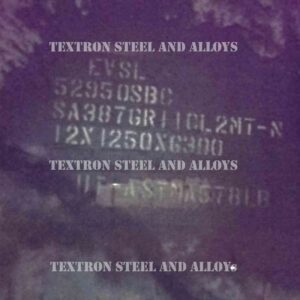Description
ASME SA 387 Grade 22 Class 2 / ASTM A387 Grade 22 Class 2
Chrome Moly Plates / Pressure Vessel Steel Plates
ASME SA 387 Grade 22 Class 2 and ASTM A387 Gr22 Class 2 are 2.25% chromium – 1% Molybdenum and effective working temperature up to 600°C, these Chromium and Molybdenum pressure vessel steel plates can effectively works very well in elevated temperatures with minimum aging of the product after thousands of hours of work.
The Molybdenum component in the SA387 ; A387 alloy, as well as increasing the tensile strength at high temperatures, also provides high resistance against oxidation and corrosion by increasing the lattice strain of the steel structure, this effectively stops the corrosive agents from dissolving the iron out of the steel structure, good for heat-resistant pressure vessels and good option for sour gas environments.
ASTM A387 Gr. 22-2 and ASME SA387-22-2 steel is characterized by good weldability. These types of steel are used above all for manufacturing boilers, pressure vessels and pipes for the transportation of hot liquids. They also offer good properties at high and low temperatures. The product is always supplied in the normalized and tempered condition.
SA387 GR 22 CLASS 2 We Textron Steel & Alloys supply ASME SA387 Grade 22 Class 2 plates to fabricators serving the oil, gas and petrochemical industry. These industries require a pressure vessel grade steel which works well in elevated temperatures and our material serves this purpose well. And with good corrosion and oxidation resistance, SA387 Grade 22 Class 2 plates are a good option.
This steel grade steel plates are commonly being addressed as A387-22-2 ; SA387 Gr22-2; SA387 Gr22 Cl2; A387-22 Cl2, Chromium and Molybdenum pressure vessel steel plates; chrome moly pressure vessel plates and etc….
Popular Uses :
SA387 Chrome Moly steel plates are popular used by power plant and oil and gas industries in the production facilities because of the alloy’s key properties.
High Tensile Strength at High Temperatures :
A387 Chrome Moly steel has a much higher heat resistance than other carbon steels and it is thus exceptionally useful for applications where hot fluids or gases are being processed at high temperatures.
The chromium and the molybdenum are the key alloying elements. They provide many of the properties of stainless steel at a reduced costs. (typically A387 alloy steel has 0.5% to 5% Chromium content as opposed to 16% in stainless steel)
Chemical Requirements for ASME SA387 Grade 22 Alloy Steel Plates :
| Element | Chemical Composition (%) | |
| SA387 Grade 22 | ||
| Carbon: | Heat Analysis: | 0.05 – 0.15 |
| Product Analysis: | 0.04 – 0.15 | |
| Manganese: | Heat Analysis: | 0.30 – 0.60 |
| Product Analysis: | 0.25 – 0.66 | |
| Phosphorus: | Heat Analysis: | 0.035 |
| Product Analysis: | 0.035 | |
| Sulphur (max): | Heat Analysis: | 0.035 |
| Product Analysis: | 0.035 | |
| Silicon: | Heat Analysis: | 0.50 max |
| Product Analysis: | 0.50 max | |
| Chromium: | Heat Analysis: | 2.00 – 2.50 |
| Product Analysis: | 1.88 – 2.62 | |
| Molybdenum: | Heat Analysis: | 0.90 – 1.10 |
| Product Analysis: | 0.85 – 1.15 | |
Tensile Requirements for ASME SA387 Grade 22 Alloy Steel Plates Class 2 Plates :
| Designation: | Requirement: | Grade 22 |
| SA387 Grade 22 | Tensile strength, ksi [MPA] | 75 to 100 [515 to 690] |
| Yield strength, min, ksi [MPa]/(0.2% offset) | 45 [310] | |
| Elongation in 8 in. [200mm], min % | ||
| Elongation in 2 in. [50mm], min, % | 18 | |
| Reduction of area, min % | 45 (measured on round specimen) | |
| 40 (measured on flat specimen) |




